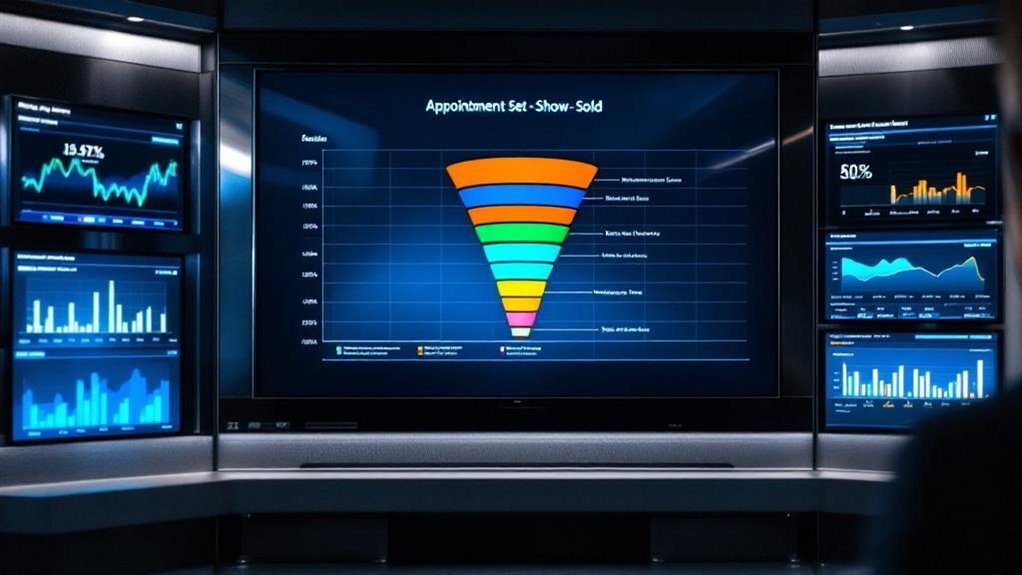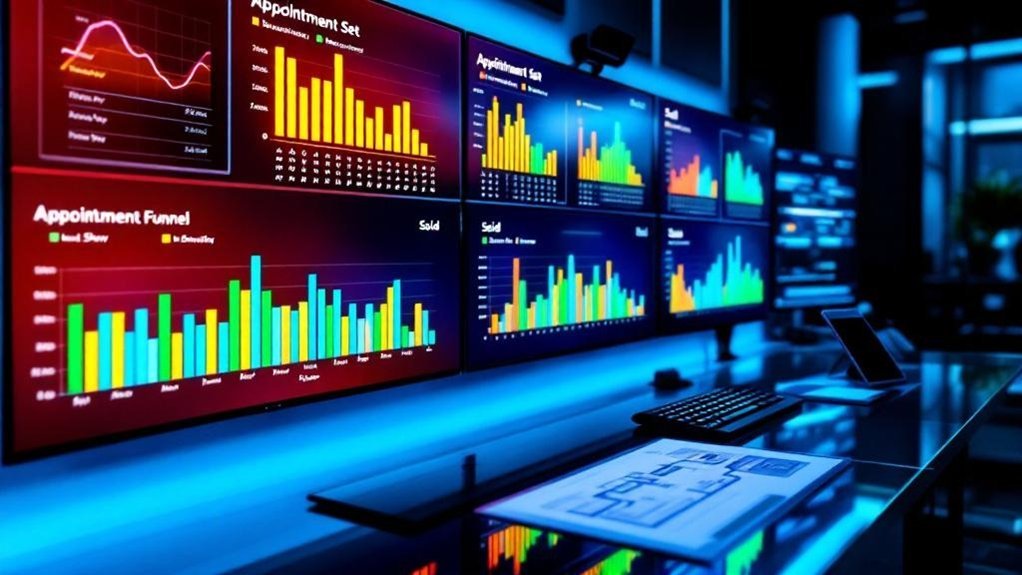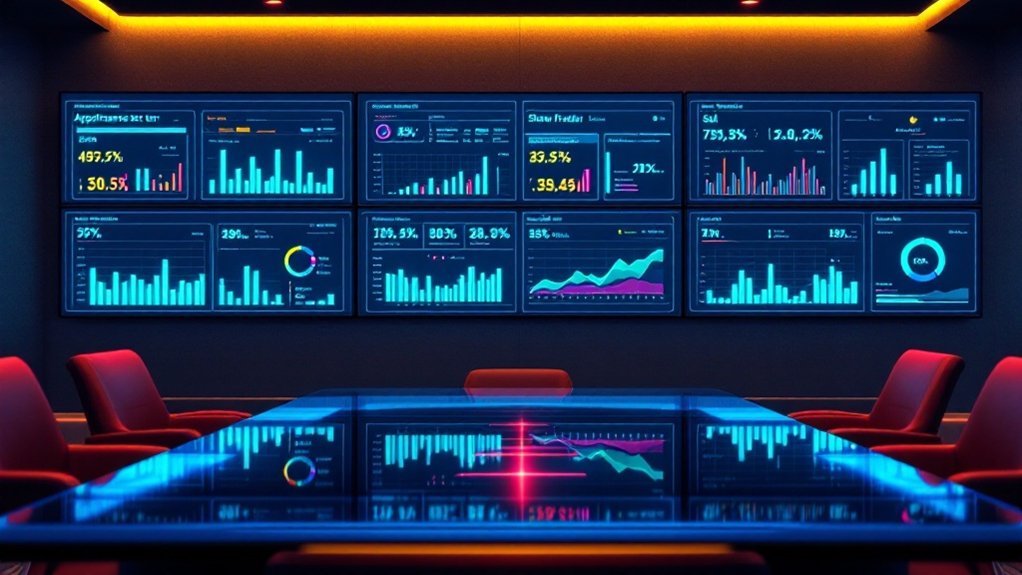You’ll track TV-driven appointments from impression to close using show rates, conversion percentages, and CPA to prove ROI and optimize campaigns. Monitor show rate (70–85%+ target), appointment-to-sale conversion (avg 5–7%, aim 12%+), and call-to-appointment yield. Use cross-device identity resolution and server-side tracking for accurate attribution. Boost show rates with clear CTAs, multi-channel reminders, and pre-appointment content. Automate follow-ups and A/B test sequences to lift conversions—keep going to see practical tactics and measurement formulas.
Key Takeaways
- Track appointment-set, show, and sold rates from CTV impressions to quantify TV-driven pipeline performance.
- Aim for show rates ≥85% using multi-channel reminders, pre-appointment content, and clear TV CTAs.
- Measure conversion targets: national average 5–7% with top teams achieving ≥12% from show to sale.
- Use cross-device identity resolution and server-side tracking to attribute TV touches to bookings and sales.
- Calculate CPA and ROAS by linking ad spend to appointments, show rates, and closed sales for ROI.
Defining the Appointment Set–Show–Sold Funnel for TV Environments

One clear way to evaluate TV-driven lead programs is the Appointment Set–Show–Sold funnel, which tracks prospects from initial appointment scheduling through attendance and final conversion so you can pinpoint where drop-off occurs. You’ll define each stage: appointment set captures touchpoints created by CTV advertising that generate qualified leads; show measures the percentage who attend, with show rates commonly 70–85%; and sold records conversions, where conversion rates average 5–7%, with top teams hitting 12%+. You’ll use data analytics to link ad exposure to appointment set rates, isolate weak handoffs, and prioritize tactics that lift attendance—personalized outreach and timely reminders. Ongoing monitoring lets you recalibrate targeting and messaging to improve lead quality and overall funnel yield.
Key Metrics to Track Across Each Funnel Stage
Because every stage in the Appointment Set–Show–Sold funnel directly affects ROI, you should track a focused set of metrics—show rate, conversion rate, call-to-appointment rate, follow-up efficiency, and marketing-sourced appointments—to pinpoint where leads drop and which tactics move the needle. Monitor show rate (national 70–75%; aim ≥85%) to maximize sales opportunity from scheduled appointments. Track conversion rates (average 5–7%; target ≥12%) to assess closing effectiveness. Measure call-to-appointment rate to evaluate outreach quality and appointment yield. Quantify follow-up efficiency by response time, touch cadence, and personalization impact on appointment retention. Isolate marketing-sourced appointments to compare channels on lead quality and ROI. Use these KPIs together to prioritize interventions, reallocate spend, and iterate scripts and timing for measurable uplifts.
Collecting and Integrating Viewer Data for Accurate Attribution

To attribute CTV-driven appointments accurately, you’ll need cross-device identity resolution that links impressions on TVs to actions on phones and desktops. Pair that with server-side tracking integration to reduce data loss from browser and device restrictions and maintain a reliable event stream into your CRM. Together these approaches let you quantify which CTV touches lead to bookings and optimize spend based on true conversion paths.
Cross‑Device Identity Resolution
When you combine device fingerprinting, login signals, and cross‑platform telemetry, you get a unified viewer profile that lets you attribute conversions across connected TVs, mobiles, and desktops with far greater precision. You’ll use cross-device identity resolution to tie CTV impressions to downstream actions, measure engagement with CTV, and surface qualified prospects. That clarity boosts campaign effectiveness (studies show up to 30%) and helps you allocate marketing budget to channels that drive appointments and sales.
| Metric | Impact |
|---|---|
| Unified profiles | Better attribution |
| CTV linkage | Improved targeting |
| Multi‑device reach | Holistic reach |
| Qualified prospects | Higher conversion |
| Budget allocation | Enhanced ROI |
Implement consistently, prioritize privacy, and report deterministic + probabilistic matches for strategic decisions.
Server‑Side Tracking Integration
Linking cross‑device identities gives you a clearer view of who saw your CTV ads; server‑side tracking is how you reliably capture and act on that view. You’ll collect viewer data directly from the server, reducing reliance on client cookies and improving data security and privacy. With real‑time integration, you can measure viewer engagement and completion rates more reliably, tying exposures to downstream actions. That accurate attribution lets you correlate CTV impressions with appointments scheduled, conversions and revenue, so you optimize spend toward high‑impact inventory. Server‑side feeds also streamline KPI reporting—video completion rates, cost per completed view and conversion lift—so you act faster on performance signals. Implement it to close gaps between exposure and measurable outcomes.
Strategies to Increase Show Rates From Tv-Driven Appointments
You should start by testing a clear TV call-to-action that tells viewers exactly how and when to book, since stronger CTAs directly improve conversion and downstream show rates. Follow up with pre-appointment content (short videos or FAQs) that sets expectations and highlights the appointment’s value to reduce cancellations. Then deploy multi-channel reminders—personalized SMS/email 24–48 hours out plus one call or ad touch—to reinforce the commitment and can lift attendance by up to ~20% when combined with value-focused messaging.
Clear TV Call-to-Action
Because TV viewers act fast, a clear, compelling call-to-action in your spot can measurably boost appointment show rates by reducing friction and guiding immediate next steps. Use a single, explicit CTA—book now, scan the QR code, or text to confirm—and make it visually dominant for at least three seconds. Embed a QR code that lands on a pre-filled booking page to reduce taps and drop-off, which helps reduce no-shows. Pair CTAs with personalized TV ad messages that reference viewer segments or local offers to increase perceived value and commitment. Track CTA-to-show conversion and A/B test phrasing, placement, and incentives (exclusive offers, priority slots). Finally, capture consent for SMS/email reminders at booking to close the loop and further lift appointment show rates.
Pre-Appointment Content
While viewers often book immediately after a TV spot, the content they see between booking and the appointment is decisive for show rates; tailored pre-appointment materials—concise educational pieces, relevant case studies, and short personalized videos—build trust and reduce no-shows by increasing perceived value. You should deploy pre-appointment content that reinforces the TV message: dynamic CTV ads for recall, one-page case studies for credibility, and personalized video messages to strengthen rapport (they can lift attendance up to ~30%). Embed QR codes in CTV ads to let viewers confirm or access details instantly. Pair these assets with automated reminders timed 24–48 hours prior to cut no-shows. Measure lift by comparing show rates among cohorts exposed to each asset.
Multi-Channel Reminders
Someone who responds to a TV spot is only halfway there — multi-channel reminders close the loop by delivering concise, personalized prompts across email, SMS, and even CTV to boost show rates. You should deploy automated reminders that layer channels to match recipient preferences; data shows this approach can push appointment show rates from ~70–75% to 85%+. Use personalized reminder messages to increase attendance up to 20% by referencing name, time, and relevant offer. Add short video content in CTV and email to reinforce details and improve retention. Include QR codes in CTV creative so recipients can reschedule or confirm with one tap. Track channel performance, optimize cadence, and automate failover to the next channel when a reminder isn’t acknowledged.
Optimizing Post-Show Follow-Up to Boost Conversion Rates
If you want to close more deals from shows, a structured post-show follow-up process is essential: timely, automated sequences with personalized content and reminders can boost conversion rates by up to 30% while A/B testing timing and messages can lift engagement another ~20%. You should tie appointment set data to a repeatable follow-up process that uses automated email sequences to nurture leads without losing personalization. Prioritize quick touchpoints, targeted resources tied to the show topic, and short surveys to capture feedback and intent. Run A/B tests on subject lines, send times, and CTAs, then iterate based on response and conversion analytics. Measure time-to-contact, engagement lift, and close rates so you can scale what proves most effective.
Automation and Workflow Tools for TV-Centric Appointment Funnels

Because TV-driven leads often come in bursts tied to airtime and promos, you’ll need automation and workflow tools that handle volume, speed, and qualification without sacrificing personalization. Leverage automation tools integrated with CRM software to auto-populate records, trigger qualification forms, and push high-quality leads to a scheduling tool. Add chatbot integrations for 24/7 engagement to capture off-hour prospects and increase bookings. Configure workflow tools to run timed follow-up sequences and automated reminders—data shows reminders can cut no-shows up to 30% and improve appointment show rates by ~20%. Use analytics hooks to monitor KPIs in real time and iterate sequences that lift conversions by up to 25%. This stack optimizes throughput from TV air to booked, shown, and sold appointments.
Measuring ROI: From Ad Spend to Closed Sales
The automation stack gets prospects from air to calendar, but you need hard numbers to know whether those appointments turn your ad dollars into profit. You’ll focus on measuring ROI by linking ad spend to appointment-setting metrics, show rates and closed sales. Track lead→appointment and appointment→sale conversion rates, then compute CPA: total ad spend divided by closed sales. Monitor show rates closely—improvements there increase conversion opportunities without extra ad spend. Use analytics to correlate channels, creatives and workflows with closed sales so you can reallocate budget to high-ROAS tactics. Regularly adjust KPIs and test optimizations to lower CPA and raise ROAS, making your TV-driven funnel a predictable revenue engine.
| Metric | Action |
|---|---|
| CPA | ad spend/closed sales |
| Show Rate | attended/scheduled |
| Conversion | appointment→sale |
| ROAS | revenue/ad spend |
Frequently Asked Questions
What Is an Appointment Funnel?
An appointment funnel is a structured appointment booking system that guides prospects through the customer journey, boosting lead conversion with engagement tactics, automated touchpoints and scheduling logistics, aligning with your sales strategy to increase booked appointments.
What Is a Funnel Metric?
A funnel metric is a compass needle: it quantifies funnel stages and conversion rates, showing how your customer journey and lead generation flow. You’ll use it to measure sales efficiency, pinpoint drop-offs, and drive strategic improvements.
What Are the Metrics for Saas Funnel?
You should track CAC, CLV, churn, MRR, SaaS conversion rates, user engagement, lead nurturing effectiveness, sales conversion, and revenue growth; use cohort analysis, retention metrics, and funnel conversion checkpoints to optimize customer acquisition and lifetime value.
What Does a Funnel Measure?
A funnel measures how dramatically prospects progress through funnel stages, quantifying conversion rates, revealing lead nurturing efficacy, mapping the customer journey, and pinpointing sales performance gaps so you can optimize tactics with strategic, data-driven clarity.
Conclusion
You’ve mapped the appointment set–show–sold funnel for TV, and the data proves the theory: clearer attribution turns fuzzy impressions into predictable pipeline. Imagine every TV spot as a precise trigger—more sets, higher show rates, tighter follow-ups, faster closes. Use integrated viewer signals, automated workflows, and targeted reminders to push percentages up at each stage. With disciplined measurement and iterative optimization, your TV dollars stop buying reach and start buying verifiable, repeatable revenue.
